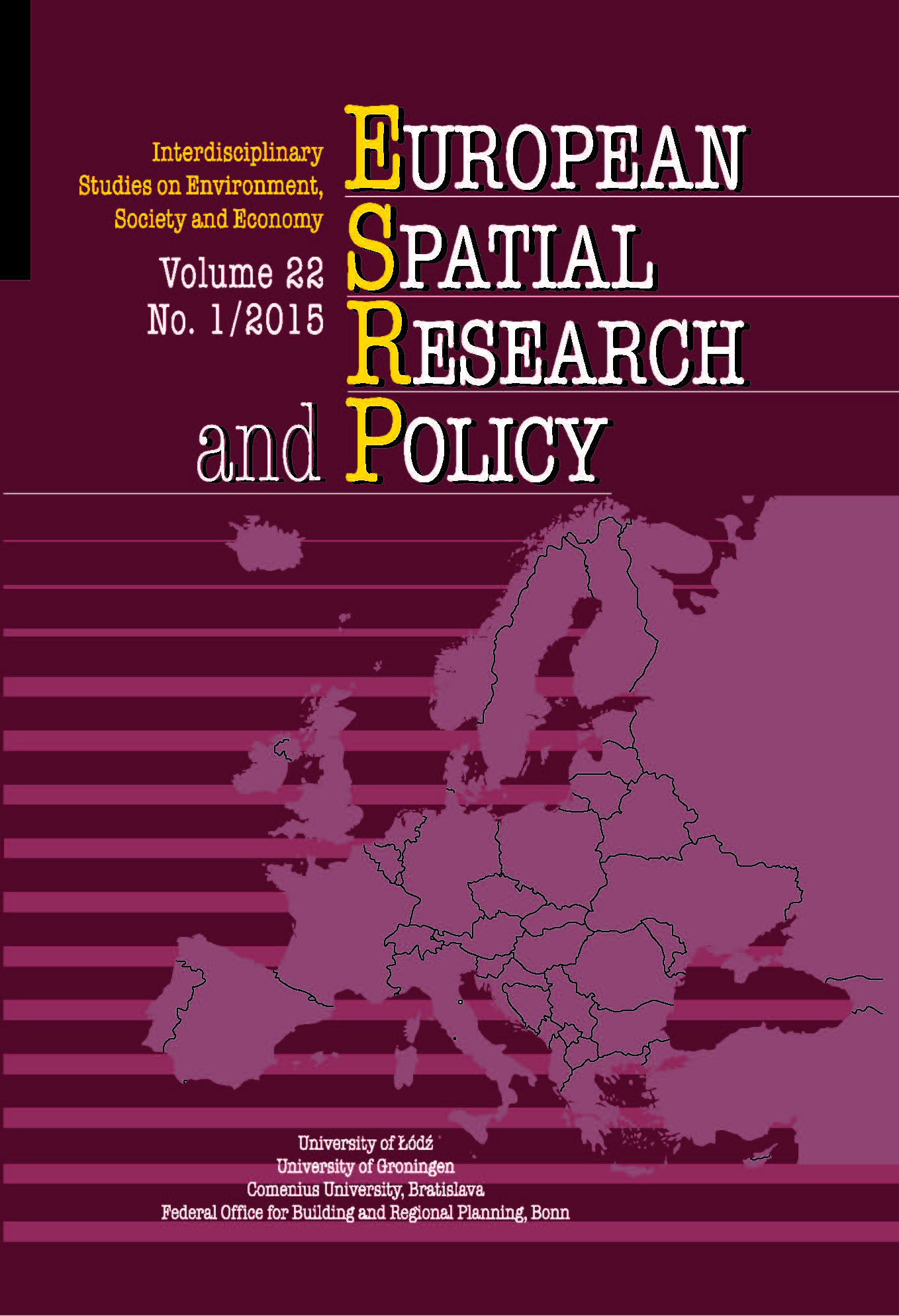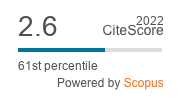Mapping the Shadow Economy: Spatial Variations in the use of High Denomination Bank Notes in Brussels
DOI:
https://doi.org/10.1515/esrp-2015-0014Keywords:
informal economy, undeclared work, cash deposits, BrusselsAbstract
The aim of this paper is to map the spatial variations in the size of the shadow economy within Brussels. Reporting data provided by the National Bank of Belgium on the deposit of high denomination banknotes across bank branches in the 19 municipalities of the Brussels-Capital Region, the finding is that the shadow economy is concentrated in wealthier populations and not in deprived or immigrant communities. The outcome is a call to transcend the association of the shadow economy with marginalized groups and the wider adoption of this indirect method when measuring spatial variations in the shadow economy.
Downloads
References
AHMAD, A. N. (2008), ‘Dead Men Working: Time and Space in London’s (“Illegal”) Migrant Economy’, Work, Employment and Society, 22 (2), pp. 301-318.
Google Scholar
BARTHE, M-A. (1985), ‘Chomage, travail au noir et entraide familial’, Consommation, 3, pp. 23-42.
Google Scholar
BARTLETT, B. (1998), ‘The Underground Economy’, National Center for Policy Analysis, http//:www.ncpa.org/ba/ba273.html (9.06.2010).
Google Scholar
BUEHN, A. and SCHNEIDER, F. (2012), ‘Shadow Economies around the World: Novel Insights, Accepted Knowledge and New Estimates’, International Tax and Public Finance, 19, pp. 139-171.
Google Scholar
CARTER, M. (1984), ‘Issues in the Hidden Economy: A Survey’, Economic Record, 60 (170), pp. 209-221.
Google Scholar
CASTREE, N., COE, N. M., WARD, K. and SAMERS, M. (2004), Spaces of Work: Global Capitalism and the Geographies of Labour, London: Sage.
Google Scholar
CORNUEL, D. and DURIEZ, B. (1985), ‘Local Exchange and State Intervention’, [in:] REDCLIFT, N. and MINGIONE, E. (eds.), Beyond Employment: Household, Gender and Subsistence, Oxford: Basil Blackwell.
Google Scholar
EUROPEAN COMMISSION (1998), Communication of the Commission on Undeclared Work, http://europa.eu.int/comm/employment_social/empl_esf/docs/com98-219_en.pdf (12.04.2007).
Google Scholar
EUROPEAN COMMISSION (2007a), ‘Stepping up the Fight against Undeclared Work’, COM (2007) 628 final, Brussels.
Google Scholar
EUROPEAN COMMISSION (2007b), Special Eurobarometer 284: Undeclared Work in the European Union, Brussels.
Google Scholar
EUROPEAN COMMISSION (2014), Economic and Social Developments in Europe 2013, Brussels.
Google Scholar
EVASON, E. and WOODS, R. (1995), ‘Poverty, Deregulation of the Labour Market and Benefit Fraud’, Social Policy and Administration, 29 (1), pp. 40-55.
Google Scholar
FEIGE, E. L. (2012), ‘The Myth of the “Cashless Society”? How Much of America’s Currency Is Overseas’, http://www.bundesbank.de/Redaktion/EN/Downloads/Core_business_areas/Cash_management/conferences/2012/2012_02_27_eltville_03_feige_paper.pdf?__blob=publication File (20.12.2012).
Google Scholar
FLAMING, D., HAYDAMACK, B. and JOASSART, P. (2005), Hopeful Workers, Marginal Jobs: LA’s Off-the-Books Labor Force, Los Angeles: Economic Roundtable.
Google Scholar
FORTIN, B., GARNEAU, G., LACROIX, G., LEMIEUX, T. and MONTMARQUETTE, C. (1996), L’économie souterraine au Québec: mythes et réalités, Laval: Presses de l’Université Laval.
Google Scholar
FREUD, D. (1979), ‘A Guide to Underground Economics’, Financial Times, 9 April, p. 16.
Google Scholar
FRIEDMAN, E., JOHNSON, S., KAUFMANN, D. and ZOIDO, P. (2000), ‘Dodging the Grabbing Hand: The Determinants of Unofficial Activity in 69 Countries’, Journal of Public Economics, 76 (3), pp. 459-493.
Google Scholar
GHK and FONDAZIONE BRODOLINI (2009), Study on Indirect Measurement Methods for Undeclared Work in the EU, Brussels: European Commission.
Google Scholar
GUTMANN, P. M. (1977), ‘The Subterranean Economy’, Financial Analysts Journal, 34 (11), pp. 26-27.
Google Scholar
GUTMANN, P. M. (1978), ‘Are the Unemployed, Unemployed?’, Financial Analysts Journal, 34(1), pp. 26-29.
Google Scholar
HART, K. (1973), ‘Informal Income Opportunities and Urban Employment in Ghana’, Journal of Modern African Studies, 11 (1), pp. 61-89.
Google Scholar
HELLBERGER, C. and SCHWARZE, J. (1986), Umfang und struktur der nebenerwerbstatigkeit in der Bundesrepublik Deutschland, Berlin: Mitteilungen aus der Arbeits-market- und Berufsforschung.
Google Scholar
HENRY, J. (1976), ‘Calling in the Big Bills’, Washington Monthly, 5, 6.
Google Scholar
INTERNATIONAL LABOUR OFFICE (ILO), (2002), Decent Work and the Informal Economy, Geneva: International Labour Office.
Google Scholar
KATUNGI, D., NEALE, E. and BARBOUR, A. (2006), People in Low-Paid Informal Work, York: Joseph Rowntree Foundation.
Google Scholar
KESTELOOT, C. and MEERT, H. (1999), ‘Informal Spaces: The Geography of Informal Economic Activities in Brussels’, International Journal of Urban and Regional Research, 23 (2), pp. 232-251.
Google Scholar
LEYSHON, A. and THRIFT, N. (1995), ‘Geographies of Financial Exclusion: Financial Abandonment in Britain and the United States’, Transactions of the Institute of British Geographers, 1 (1), pp. 312-341.
Google Scholar
MATTHEWS, K. (1982), ‘The Demand for Currency and the Black Economy in the UK’, Journal of Economic Studies, 9 (2), pp. 3-22.
Google Scholar
MERIKÜLL, J. and STAEHR, K. (2010), ‘Unreported Employment and Envelope Wages in Mid-Transition: Comparing Developments and Causes in the Baltic Countries’, Comparative Economic Studies, 52, pp. 637-670.
Google Scholar
MINGIONE, E. and MORLICCHIO, E. (1993), ‘New Forms of Urban Poverty in Italy: Risk Path Models in the North and South’, International Journal of Urban and Regional Research, 17(3), pp. 413-427.
Google Scholar
OECD, (2002), Measuring the Non-Observed Economy, Paris.
Google Scholar
OECD, (2012), Reducing Opportunities for Tax Non-Compliance in the Underground Economy, Paris.
Google Scholar
ONOSHCHENKO, O. and WILLIAMS, C. C. (2013), ‘Paying for Favours: Evaluating the Role of Blat in Post-Soviet Ukraine, Debate’, Journal of Contemporary Central and Eastern Europe, 21 (2-3), pp. 259-277.
Google Scholar
PAGLIN, M. (1994), ‘The Underground Economy: New Estimates from Household Income and Expenditure Surveys’, The Yale Law Journal, 103 (8), pp. 2239-2257.
Google Scholar
PAVLOVSKAYA, M. (2004), ‘Other Transitions: Multiple Economies of Moscow Households in the 1990s’, Annals of the Association of American Geographers, 94, pp. 329-351.
Google Scholar
PESTIEAU, P. (1985), ‘Belgium’s Irregular Economy’, [in:] GAERTNER, W. and WENIG, A. (eds), The Economics of the Shadow Economy, Berlin: Springer Verlag.
Google Scholar
RAM, M. and WILLIAMS, C. C. (2008), ‘Making Visible the Hidden: Researching Off-the-Books Work’, [in:] BUCHANAN, D. and BRYSON, A. (eds.), Handbook of Organizational Research Methods, London: Sage.
Google Scholar
SCHNEIDER, F. (2005), ‘Shadow Economy around the World: What Do We Really Know?’, European Journal of Political Economy, 21 (2), pp. 598-642.
Google Scholar
SCHNEIDER, F. and WILLIAMS, C. C. (2013), The Shadow Economy, London: Institute of Economic Affairs.
Google Scholar
TANZI, V. (1980), ‘The Underground Economy in the United States: Estimates and Implications’, Banco Nazionale del Lavoro, 135, pp. 427-453.
Google Scholar
VAN GEUNS, R., MEVISSEN, J. and RENOOY, P. (1987), ‘The Spatial and Sectoral Diversity of the Informal Economy’, Tijdschrift voor Economische en Sociale Geografie, 78 (5), pp. 389-398.
Google Scholar
WILLIAMS, C. C. (2004), Cash-in-Hand Work: The Underground Sector and the Hidden Economy of Favours, Haunddemills and Hampshire: Palgrave Macmillan Basingstoke.
Google Scholar
WILLIAMS, C. C. (2009a), ‘Evaluating the Extent and Nature of Envelope Wages in the European Union: A Geographical Analysis’, European Spatial Research and Policy, 16 (1), pp. 115-129.
Google Scholar
WILLIAMS, C. C. (2009b), ‘Formal and Informal Employment in Europe: Beyond Dualistic Representations’, European Urban and Regional Studies, 16 (2), pp. 147-159.
Google Scholar
WILLIAMS, C. C. (2013), ‘Evaluating Cross-National Variations in the Extent and Nature of Informal Employment in the European Union’, Industrial Relations Journal, 44 (5-6), pp. 479-494.
Google Scholar
WILLIAMS, C. C. and LANSKY, M. (2013), ‘Informal Employment in Developed and Emerging Economies: Perspectives and Policy Responses’, International Labour Review, 152 (3-4), pp. 355-380.
Google Scholar
WILLIAMS, C. C. and PADMORE, J. (2013a), ‘Envelope Wages in the European Union’, International Labour Review, 152 (3-4), pp. 411-430.
Google Scholar
WILLIAMS, C. C. and PADMORE, J. (2013b), ‘Evaluating the Prevalence and Distribution of Quasi- Formal Employment in Europe’, Relations Industrielles/Industrial Relations, 68 (1), pp. 1-95.
Google Scholar
WILLIAMS, C. C. and WINDEBANK, J. (1994), ‘Spatial Variations in the Informal Sector: A Review of Evidence from the European Union’, Regional Studies, 28 (8), pp. 819-825.
Google Scholar
WILLIAMS, C. C. and WINDEBANK, J. (1995), ‘The Implications for the Informal Sector of European Union Integration’, European Spatial Research and Policy, 2 (1), pp. 17-34.
Google Scholar
WILLIAMS, C. C., ROUND, J. and RODGERS, P. (2013), The Role of Informal Economies in the Post-Soviet World: the End of Transition?, London: Routledge.
Google Scholar
Downloads
Published
How to Cite
Issue
Section
License

This work is licensed under a Creative Commons Attribution-NonCommercial-NoDerivatives 4.0 International License.














